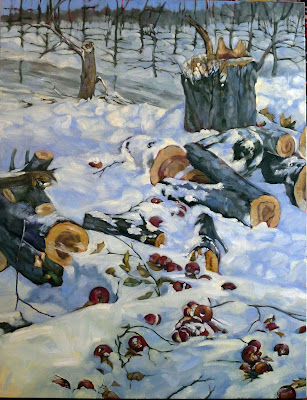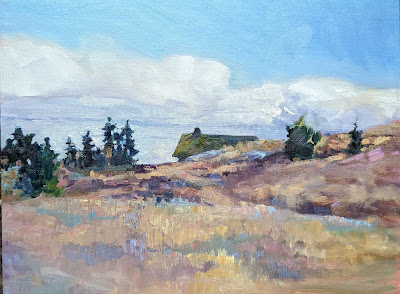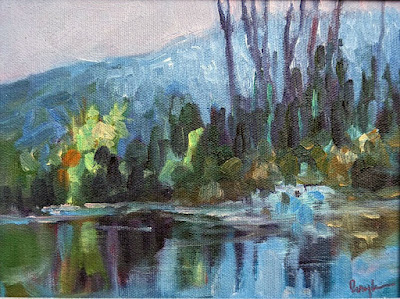It’s a mistake to think of our large canvases as drugs on the market. They’re often the most important work we do.
 |
| Winter Lambing, 36X48, oil on canvas, $6231 framed. |
Björn Runquist told me about the perambulations of a large work, 72” high, as we hung paintings at Bangor Savings Bank yesterday. It takes time to sell a major painting, so it’s no surprise that his canvas is more well-traveled than some of my friends. Like actors, these big works ‘rest’between gigs. They can take up almost as much house-room as a twenty-something between jobs.
My out-of-work canvases live in the closets of our guest room. That’s an improvement, because until this house, we didn’t have a guest room; we just had lots of bedrooms for our numerous children. Then, my inventory was stored behind a false wall in my room. It was the antithesis of House Beautiful, and it irritated me every time I saw it. My husband studied aesthetics as undergraduate, but it never bothered him. Go figure.
 |
| Vineyard, 30X40, oil on canvas, $5072 framed. |
There are many large canvases in my storage, because I love to paint big: God + Man, which I did originally for a solo show at Roberts Wesleyan College, and a whole slew of nudes that were censored at Rochester Institute of Technology. The latter will be going to the Rye Arts Center in New York in March, for a duo show with sculptor Anne De Villemejane.
We artists love to paint big, but it’s easier to sell smaller paintings. They fit better on people’s walls, and they cost less money. Still, it’s a mistake to think of these large canvases as a drug on the market. Because they require such careful thought, they’re often the most important work we do. It makes sense to think of them as an asset that should be carefully rationed into the marketplace, rather than as large, bulky objects we trip over, that we’re only too happy to sell to the first comer.
 |
| Breaking Storm, 30X48, is available through the Camden Public Library this month. |
Surplus art is our lot in life. For example, Ken DeWaard counted up the unfinished work in his studio at the end of the summer and announced he had something like 145 unfinished canvases in his studio. I haven’t counted mine, but it’s something similar; we’re like musicians in that we must constantly practice. We might finish or paint over them; we ruthlessly cull them before we show them, or we’d never have room for them all.
Between changing out the show at Camden Library and hanging paintings at the bank, I have moved a lot of paintings from place to place. It’s an excellent opportunity to bring the nudes out for an airing, as they need to be cleaned and rewrapped before they travel down to New York. “I hope you sell a lot of them!” my friend Marjean exclaimed. She’s speaking from the housewife’s standpoint here; she’d really like to see that closet better-organized.
 |
| All Flesh is as Grass, 30X48, oil on canvas, $6231 framed. |
I’m just thrilled to have an opportunity to show those paintings again. The lot of women worldwide wasn’t great when I painted them, and it hasn’t gotten any better.
Meanwhile, I’ll be at Camden Public Library tomorrow from 1 to 3, for a reception for Fantastic Places and Magical Realms. The work ranges in size from 6X8 to 30X48, so there’s something suitable for every space and budget. Stop by and I’ll give you your Christmas treat.















